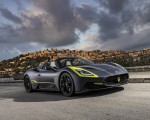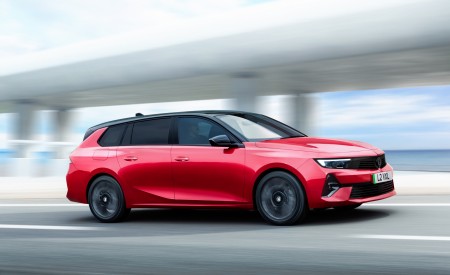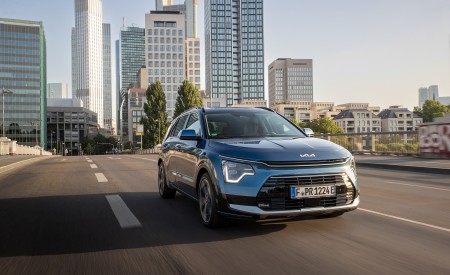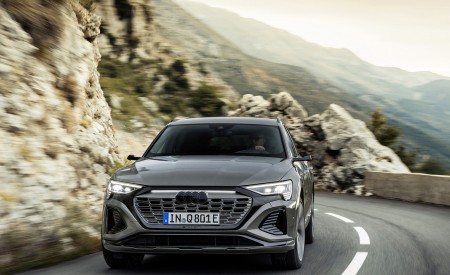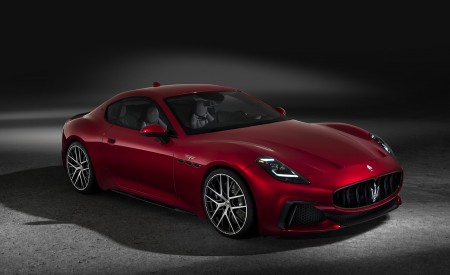2023 Maserati MC20 Cielo
- Maserati presents the MC20 Cielo, a new, one-of-a-kind spyder, taking the driving experience to a holistic and immersive level.
- MC20 Cielo stands out for its electrically retractable glass roof , the epitome of technology. Maserati is innovative by nature: Polymer-Dispersed Liquid Crystal (PDLC) technology makes it possible for the roof to be turned clear or opaque in an instant. The central display can also be used to operate the roof at a speed of up to 50 km/h, in complete safety.
- The in-car experience is multi-faceted: all-encompassing with the roof closed and opaque; a unique “sky feeling” when the roof is transparent; multi-sensory with the top down.
- Other standout features include the thermal insulation in the glass roof – the largest in the segment – and an opening and closing speed of just 12 seconds.
- The PrimaSerie Launch Edition of Maserati MC20 CIELO exclusively features a new three-layer color known as Acquamarina, as part of the Maserati Fuoriserie customization program. In addition to the limited color, the Primaserie MC20 CIELO will also feature exclusive content.
- The new model retains the best-in-class specifications of the MC20 super sports car: bold in every respect, it epitomizes Maserati’s typical GranTurismo spirit. The spyder is designed for perfection, while maintaining the dynamic performance and driving pleasure of the coupé.
- Excellent power-to-weight ratio, with minimal increase in weight from the coupé. The body is made of carbon fiber and composite materials in its entirety, an identical solution for all the configurations to come: coupé, spyder and, in the future, electric.
- Storage space and interior roominess remain unchanged from the coupé version.
- Refined, clean and innovative 360° aerodynamics, tested in a wind tunnel.
- Great acoustic comfort to ensure everyday usability, minimising vibrations.
Performance and comfort: the dual souls of Maserati, harking back to the brand’s racing roots and its iconic GranTurismo spirit. These features are now taken to a new level in terms of performance and driving pleasure in the great outdoors: Maserati presents the MC20 CIELO spyder.
Equipped with the revolutionary V6 Nettuno engine that made its debut in the 2020 MC20, MC20 CIELO offers a perfect mix of sportiness and luxury, courtesy of a specification unique to the segment: the innovative retractable glass roof.
A “first of its kind” and best-in-class in terms of thermal insulation, of opening and closing speed (just 12 seconds), and of how it epitomizes the best in technology.
To do so, the new model is equipped with a state-of-the-art electrochromic (smart glass) window that can instantly be transformed from clear to opaque at the touch of a button on the central screen, courtesy of Polymer-Dispersed Liquid Crystal (PDLC) technology.
As such, MC20 CIELO provides a multi-faceted driving experience: all-encompassing with the roof closed and opaque; a unique “sky feeling” when the roof is transparent; holistic with the top down.
When a coupé is transformed into a convertible, the increase in weight is usually a major challenge. Innovative by nature, Maserati has managed to limit this and maintain the innate sporty DNA of the MC20.
The MC20 Cielo weighs just 65 kg (143 pounds) more than the coupé, made possible by meticulous, precise work during the stages of the car’s design. By limiting the increase in weight to around 60 kg, Maserati maintains the dynamic performance and driving pleasure of the coupé version in the MC20 Cielo.
The carbon fiber chassis also guarantees uncompromising torsional rigidity, offering a combination of extraordinary handling on the road and on the track.
The new model also adds a wide range of Active Safety Systems, unlike any other model ever has in this segment. As well as the parking sensors, rear-view camera and blind spot monitoring included in the MC20 since the MY22, the new spyder introduces available autonomous emergency brake, traffic sign information and a new 360° camera and the Surround View 360° system, to help with parking manoeuvres using four extra cameras.
The new spyder will broaden the MC20 range and will bring Maserati into the segment of convertible sports cars. The brand intends to expand its offering to cover the convertible segment, which represents 35% of the global super sports car market.
A spyder with a one-of-a-kind roof
The innovative electrically retractable glass roof
MC20 Cielo is “First of its Kind”, bold in every respect and designed for perfection, all the way to the smallest detail. The component that makes it stand out from every other spyder is the electrically retractable glass roof, the epitome of technology.
The clear glass roof, the largest in the segment, is 909 mm long, 615 mm wide and has a surface area of more than half a square meter (5,268 cm2).
MC20 Cielo is the only model in its class with a fully retractable glass roof as standard, with no impact on the car’s storage space. To operate it, all you need to do is tap a button on the central touchscreen: in just 12 seconds, the roof opens or closes, transforming this super sports car.
Another tap on another touch button and the glass changes from clear to opaque or vice versa.
Advanced Polymer-Dispersed Liquid Crystal (PDLC) technology makes it possible for the change of transparency to take place in an instant; it works at virtually all temperatures, from -30°C to +85°C.
Made by Maserati in partnership with Webasto, the device also guarantees perfect heat sealing and reduced in-car noise, setting the benchmark in a segment where retractable roofs are often made of canvas or sheet metal.
As usual for Maserati, innovation is accompanied by unique and immediately recognizable styling cues.
Therefore, just as the MC20 coupé proudly sports a stylized Trident – acting as a cooling air intake for the Nettuno engine – on the polycarbonate engine compartment cover, the brand’s icon can likewise make an appearance, in the optional extra of an all-new Trident decal.
The iconic Trident decal is made of matte titanium, with a special coating consisting of a film of transparent varnish.
Design
Concept and Design
The design of the MC20 Cielo was developed at the Centro Stile Maserati in Turin.
The same goes for the new spyder, its basis the history of a brand that has elegance and racing spirit in its DNA. Maserati design is the perfect combination of sportiness and character, following timeless lines that make “Visual Longevity” (an approach that transcends fashion) its manifesto.
The project stages: dialogue between design and engineering
The work of the Centro Stile Maserati begins with a briefing on the product and its engineering. At Maserati, the briefing is debated and shaped to achieve the best possible trade-off before moving on to the practical stages, taking drawings and sketches as their starting point. The design is developed throughout the project, in continuous dialogue with the engineering departments.
MC20 Cielo is a car with an elegant yet sporty design.
Its character and personality are truly eye-catching for the purity of its forms, which seem to have been carved out by the wind, whether the roof is open or closed.
Nothing is superfluous, everything has its own function. The aim at the Centro Stile Maserati was to integrate all the demands of aerodynamics in an organic way, as if the car had evolved naturally.
The only concession to a surprise effect is the butterfly doors, which also remain in the spyder.
The butterfly door provides much easier access into and out of the cabin, as well as showing off the carbon fiber cockpit, the aerodynamics and the completely unmasked front wheel.
Maserati MC20 Cielo is a project that brings together two very different worlds. Its outfit – the bodywork – represents beauty and purity; the chassis, the carbon fiber underbody, epitomizes technology and extreme performance. The upper section of the car conveys strong yet aesthetically harmonious impressions; the lower part, with its bare carbon fiber, begins with the aerodynamic floor and is rather more aggressively designed, with sharp edges and corners: everything has its own function. The front grille is the linking feature between these two worlds. It combines a bare carbon fiber lower part with a body-color top, and its form appears to consist of two components.
The front wing lacks the three air vents that served as a signature feature of Maserati models, but would be pointless here, as the engine is mid-mounted. However, they are taken back up in the channels set into the sides of the matching cover.
Exterior
A dedicated color: Acquamarina.
For MC20 CIELO, Maserati has created a new color: known as Acquamarina, it is an exclusive color that will only be available on the Primaserie Launch Edition as part of the Maserati Fuoriserie customization program.
The concept that led the brand to select this special three-layer paint consisted of taking such a high-performance car in a more contemporary direction: holistic, high-tech and uniform in color, all at once.
Maserati searched for a color that would recall driving in the great outdoors, with the wind in your hair. A fresh, luminous and light shade. An iridescent color, in its interaction with light, revealing itself in a surprising way.
The base is a pastel grey inspired by racing, reminiscent of the MC20’s sporty DNA, accompanied by an iridescent aquamarine mica that enlivens the color and makes it stand out.
MC20 Cielo is fitted out in a color that not only speaks of performance, but also serves as a nod to its racing origin by bringing together the brand’s dual souls: elegance and racing.
Other than the launch hue, MC20 Cielo revisits the color palette created for the coupé, plus Grigio Incognito (a pastel grey). The range therefore encompasses five other colors: Bianco Audace, Giallo Genio, Rosso Vincente, Blu Infinito, and Grigio Mistero.
Every one of them was developed exclusively for the MC20. All the colors were created by bringing together two aspects: a strong reference to Made in Italy, the local area and a modern reinterpretation of models and colors that have made history for the brand.
The interior of the MC20 Cielo follows the same philosophy. In the launch version, light is key, in the use of ice-colored Alcantara and leather. Below the dashboard, the ice-colored door panels and seats enhance the finishes and contribute to the visual lightness of the car in comparison to the standard version, which retains a black leather interior. The trident on the headrest can also be embroidered by hand as an optional extra.
As with all the models in the Maserati range, the new spyder can also be customised, making it a blank canvas for your own tastes, made possible by the Maserati Fuoriserie program.
PrimaSerie Launch Edition
Specially and only at launch, the MC20 Cielo is also available in the PrimaSerie Launch Edition, a limited series of around 60 models featuring exclusive content.
The very name – PrimaSerie – indicates the privilege of owning an all-new model, and makes exclusivity a clear strength.
Its unique features are clear to see, all the way to the minutest detail: the exterior in the new Acquamarina color is complemented by new MM20” wheel rims in a special version with Gold finish and laser-engraved “PrimaSerie” wording. The badges on the bodywork also come in a specific finish.
The interiors are upholstered in ice-colored Alcantara and leather, embellished with specific contrasting stitching in aquamarine on both the dashboard and the “PrimaSerie” wording on the headrest.
New wheel rims
The new Maserati spyder adds to the MC20 range of rims a new diamond-cut alloy wheel featuring a refined design, where the key component is the double XX, the Roman numeral that recalls the car’s name and the year that marked the beginning of a “new era” for Maserati. These rims are available as an optional extra for both the coupé and the spyder.
Carbon fiber wheel rims will also be available, to ensure weight savings of 30 kg in comparison to the standard version.
Interior
The interior: the realm of functionality
Maserati MC20 Cielo conveys emotions with its elegant yet sporty line, and leaves the role of pure functionality to the interior. Everything is highly streamlined, almost minimalist, with two 10-inch screens, one for the cockpit and the other, the Maserati Touch Control Plus (MTC Plus MIA) in a central position, slanted slightly towards the driver.
The tunnel is very plain, with no unnecessary ornamentation. It includes only the drive mode selector, two buttons for the gears, the power window controls and the infotainment volume control, and a space for a smartphone with wireless charging pad. All the other controls are located on the steering wheel, with the ignition button on the left and the launch control on the right.
Although the function of every component takes priority, the interior is skilfully styled with carbon fiber to act as a meeting point for lifestyle, performance and engineering. The carbon fiber in the interior is matte in finish, for a more tailored, fabric-like look.
As seen in the MY23 coupé, the spyder has benefited from upgrades to its interior and new features: new control levers have been added behind the steering wheel, as have new buttons to turn on the lights, while the Alcantara steering wheel now comes as standard, with a blue engine start button. Another major new feature is the electrical steering adjustment system, available as an optional extra for the MC20, starting from the new Cielo variant. Adding only 700 grams to the car’s weight, this specification extends the angular movement of the steering wheel and makes its adjustment even more intuitive and precise.
Sports steering wheel in Alcantara
The steering wheel is taken from the MC20, developed and designed with input from Andrea Bertolini, Maserati Reference Driver and former World Champion in the MC12. A thicker steering wheel was chosen to maximize ergonomics and the sporty ‘feel’.
Only the essential buttons and switches remain intact, including the Start and Launch Control buttons.
The easily accessible, generously sized paddle shifters set into the steering column are available in dark aluminium in the standard configuration, or in carbon fiber as part of the carbon fiber interior package.
With MC20 Cielo, as in the MY23 coupé, the steering wheel comes in Alcantara and carbon fiber with a blue engine start button.
To reaffirm the GranTurismo and racing soul of the MC20, electric steering adjustment will be available as an optional extra.
A spyder devoted to performance
Three versions of the monocoque
Entirely made of carbon fiber and composite materials, the monocoque is a rush of technology and performance; ever since the outset, it has been designed for all three types of the car: coupé, spyder and, in the future, electric.
The monocoque’s architecture and geometry are the same for all three versions, but differ in the distribution of the carbon fiber and its layers, to provide monocoques with different structural characteristics for the three different types of car: the focus for the coupé will be on limited weight and high performance; the spyder demands greater torsional rigidity given the lack of a roof; the electric version will have more overall strength and enhanced protection for the battery housing.
One single design therefore encompasses three versions, with changes only made to the type, quantity and arrangement of the carbon fiber.
Refined aerodynamics
MC20 Cielo is designed as a sculpture in movement; its refined aerodynamics have been developed with the layout of the MC20 as a starting point, using both CFD simulations and experimental testing: Computational fluid dynamics and wind tunnel on a 1:1 scale.
The retractable roof has been built into the upper part of the car, with no compromise on the cleanliness of the lines, nor on the high aerodynamic efficiency of the bodywork in the coupé version.
The engine compartment air intakes have been repositioned as a result of careful optimization using computational fluid dynamics, to avoid any adverse impact on the car’s resistance.
New boomerang-style outlets are built into the additional side fenders: the extraction of hot air from the engine compartment is maximized by exploiting the effect of the flow that passes over the fenders, while the aerodynamic efficiency of the spoiler remains unchanged.
The aerodynamically shaped B-pillar helps the air flow more cleanly over the surface, while the new rear air intakes with built-in aerodynamic deflectors optimize the direction and amount of clean air coming in via the engine intakes to cool the intercoolers.
With the roof open, the clean lines in the upper section of the car manage air flow to ensure greater comfort in the cabin: every detail has been optimized to improve efficiency, even when driving with the top down.
Special attention has also been paid to proper management of heat flows.
Its front incorporates an elaborate system of vortex generators, rendered even more effective by the distinctive hump shape of the floor. It gradually rises in the centre, in the area level with the wheels, to increase the air flow to these devices, before reconnecting to the chassis bed.
The venting channel in the area behind the front wheel starts near the point where the hump reaches its greatest extent and continues right along the side, generating a considerable vertical load in line with the front axle by expelling the air flowing from the bottom and the wheel arch.
The development of this feature, very much derived from racing, required special formation of the carbon fiber monocoque, the wheel arch and the doors, as was also the case previously for the MC12.
To conclude, the rear part of the floor of the car includes a large diffuser, with channels of different depths and optimised vertical spoilers that exploit the pressure differences between the various sections to generate vortices and energise the air flow.
Thanks to the almost obsessive care taken over the development of all these features, and the ceaseless hard work to integrate technical factors with aesthetic demands, just like its sibling coupé model, the MC20 Cielo generates a high aerodynamic load with an excellent drag, enabling it to reach top speeds over 320 km/h and continue to hug the ground in all conditions of use.
The Nettuno engine
The engine is the same revolutionary Nettuno that debuted in the coupé version. Nettuno is the result of a genuine technological revolution, protected by international patents.
A strategic operation for Maserati, a brand now preparing to launch a project “100% Made in Modena” for the MC20 and MC20 Cielo family of super sports cars, starting straight from its engine, the heart of the new car.
Nettuno has a V 90° architecture, with a 3.0-liter, 6-cylinder twin-turbo, and features a dry sump (a classic solution on super sports cars). It can deliver 630 hp (621 US hp) at 7,500 rpm and 730 Nm of torque (538 lb-ft.) from 3,000 rpm. The power-to-weight ratio is 210 hp/liter (207 US hp/liter).
The compression ratio is 11:1, the stroke is 82 mm, with a bore of 88 mm.
The soul of the engine is the innovative pre-chamber combustion system featuring twin spark plugs. This technology is derived from Formula 1 and is now available for the first time on an engine destined for the road.
Technical specifications
The driver’s seat of the MC20 Cielo is as essential, functional and streamlined as in the coupé version. The focus is entirely on the driver and their quest for optimal performance.
The central tunnel is clad with carbon fiber and only includes the buttons and switches that are absolutely essential, to maintain concentration on the driving experience and to sustain the approach of elegant minimalism, the style canon for the interior.
The most luxurious detail is the drive mode selector, in a digital version here: taking center stage, it is the distinctive feature that tells the driver and passenger they are aboard a Maserati.
New drive mode selector
The drive mode selector – positioned in the middle of the tunnel – is now a digital touch device, showing the drive mode preset by the driver, suspension calibration management and ESC Off, all on its small screen.
MC20 Cielo offers five drive modes: WET, GT, SPORT, CORSA and ESC OFF. Each one is identified by its own color: WET is green; GT blue; SPORT red; CORSA yellow; ESC OFF orange.
Drive modes are selected by turning the selector for a few seconds. For example, the car starts in GT mode by default. To switch from GT to SPORT (to the right) or WET (to the left), it only takes half a second of movement towards the mode required. Or the driver can press the selector for 2 seconds to choose CORSA mode. Once CORSA drive mode has been selected, the touchscreen can be used to switch to ESC OFF mode.
The five modes are differentiated as follows:
GT mode (default drive mode)
GT Mode is the default drive mode when the car is started. It is ideal for everyday driving and provides maximum ease of use and comfort.
- Engine boost: normal
- Pedal sensitivity: normal resistance
- Active exhaust valves: only open over 5,000 rpm
- Gear shift setting: slow and smooth
- Suspension: soft
- Traction control: normal
WET Mode
WET mode offers the highest level of control on wet or damp road surfaces, to prevent skidding during acceleration or on corners.
- Engine boost: limited
- Pedal sensitivity: normal resistance
- Active exhaust valves: only open over 5,000 rpm
- Gear shift setting: slow and smooth
- Suspension: soft
- Traction control: all controls active
SPORT Mode
SPORT mode offers the highest performance in high-traction conditions and is ideal for use on the track.
- Engine boost: normal
- Pedal sensitivity: low resistance, high sensitivity
- Active exhaust valves: open over 3,500 rpm
- Gear shift setting: fast and direct
- Suspension: rigid
- Traction control: sport
CORSA Mode
CORSA mode offers the driver the most extreme experience. Traction control is much less active and stability control is active if with very high thresholds. This mode provides maximum enjoyment, but also the most challenging handling.
- Engine boost: maximum (maximum power immediately available)
- Pedal sensitivity: low resistance, extremely sensitive and responsive
- Active exhaust valves: always open
- Gear shift setting: racing
- Suspension: racing
- Traction control: race
In Corsa mode, the driver has the option to enable Launch Control by pressing the button on the steering wheel.
ESC OFF mode
In ESC OFF mode, all control functions are disabled. It is similar to CORSA mode, but with traction control completely disabled.
Adjustable suspension
With the new digital drive mode, the way to change the suspension settings has changed. Swiping on the display switches from drive mode to suspension settings. By turning the bezel surrounding the screen, the driver can adjust rigidity depending on the drive mode selected. In the GT and SPORT drive modes, the suspension can be set to SOFT or MID, whereas in CORSA drive mode, the settings available are MID and HARD. HARD is the most rigid setting, suitable for driving conditions on the track.
MC20 Cielo has a double-wishbone suspension system with active shock absorbers. The short spindle semi-virtual double-wishbone layout is used on both the front and rear axles. This suspension type ensures the best performance in terms of handling and ride comfort.
The semi-virtual double-wishbone assembly on the front axle guarantees the best control of the steering wheel and the highest degree of steering precision, and it cushions the vibrations transmitted from the road to the steering wheel, to guarantee better overall driver comfort.
All the components are made of forged aluminium for optimal weight savings.
Transmission
The automatic transmission is an 8-speed oil-immersed Dual Clutch design with six power and two overdrive speeds to ensure emissions compliance.
Vehicle height lifter
As standard, a system is available to raise the vehicle when running at low speeds, increasing ground clearance when traversing obstacles such as speed bumps or very steep inclines. The driver can activate the system by pressing the specific button on the steering wheel. When activated, the hydraulic system raises the front axle by 50 mm. The driver can then deactivate the system by pressing the button again. At this point, the car will return to the standard ground clearance.
High Premium Sonus faber sound systemThe system works at up to 40 km/h. If the lift system is activated and the car exceeds 40 km/h, the system is deactivated automatically and the car returns to the normal height above the ground.
Similar to the 2022 MC20 Coupé, the new MC20 CIELO is equipped with an optional High Premium Sonus faber audio system. The MC20 Coupé system, an EISA award-winning in-vehicle audio system, has been specifically optimized to fit the unique acoustic and positioning needs of the RHT cabin, situating the system’s 12 speakers to result in the Natural Sound that distinguishes Sonus faber audio systems.
The High Premium Sonus faber system consists of 12 speakers:
- 2 tweeters in the door panel
- 2 mid-range speakers in the door panel
- 2 woofers in the door panel
- 1 mid-range in the middle of the dashboard
- 1 tweeter in the middle of the dashboard
- 2 mid-ranges in the rear
- 2 tweeters in the rear
In the new model, the cabin acoustics change considerably when the roof is opened or closed. The Sonus faber High Premium audio system recognises the MC20 CIELO configuration and automatically adapts the time-alignment, equalisation and sound levels, instinctively offering the best possible audio performance, in line with Sonus faber’s DNA and signature sound.
Sonus faber is an Italian manufacturer of handcrafted speakers, and other high-end audio equipment, the result of the idea of a man who loved music and its correct reproduction, but also from a person with a special sensibility about handcrafted wood products and a true reverence for beauty. The Sonus faber brand tells a story by means of sound and materials Each Sonus faber product, be it past, present or future, is able to take the listener into a world of long-lasting tradition, Italian culture and craftsmanship. Our handmade musical instruments are true to Italian expertise, with an unforgettable voice that immerses you in a natural sound experience.
Maserati Intelligent Assistant (MIA) Multimedia System
MC20 Cielo is equipped with the latest Maserati Intelligent Assistant (MIA) multimedia system. The heart of MIA is the powerful Android Automotive operating system, which offers an innovative, high-performance User Experience, fully customisable to the driver’s preferences.
MIA has two in-car screens: the digital cluster and central display, which are similar in shape and size. Neither too large nor too small, they are perfectly suited to the functional cabin interior of the MC20 Cielo; they facilitate driving comfort by not requiring the driver to refocus when going from one screen to the other.
The 10.25-inch cluster is fully digital, with a Thin Film Transistor (TFT) display.
The central display, again 10.25-inch, has an HD resolution and touchscreen functions typical of personal smart devices. The screen has a special anti-reflective coating to ensure maximum visibility even in direct sunlight.
When the devices are switched off, they have a total black effect, made possible by an innovative optical solution.
The controls to open, close and change the transparency of the roof appear on the central screen.
Maserati Connect*
MC20 Cielo is always connected, courtesy of the new Maserati Connect program.
Given that the car is connected at all times, the driver can keep an eye on the car’s condition, plus Maserati Connect issues an alert when a service is due, to improve the customer care experience. Maserati Connect also enhances safety and security, with assistance in an emergency and in the event the car is stolen.
With a smartphone or smartwatch, the driver can always remain in contact with their MC20 Cielo in the Maserati Connect app, including from home via their virtual personal assistant (Amazon Alexa & Google Assistant).
Through the MIA (Maserati Intelligent Assistant) multimedia system, the Maserati Connect connected services deliver a new experience for the driver and passengers. Courtesy of the built-in, connected navigation system, the driver always has the latest traffic information in real time, as well as constantly updated maps. MIA also offers options to activate Amazon Alexa or a Wi-Fi Hotspot inside the Maserati.
MC20 Cielo includes the TIDAL HiFi Streaming service, offering the best sound quality available by taking full advantage of the potential of the Sonus Faber Sound System.
*Availability may vary from one country to another.
The Maserati spyder in history
From the A6G 2000 to the MC20 CIELO, the spyder has a long and successful history and tradition within the Trident brand. The first convertible “opened up” in 1952 with the A6G 2000, the result of work at the Frua bodyshop and the sibling of the sports car unveiled in 1950 as the replacement for the A6 1500. The number “2000” indicated the displacement, “A” stood for Alfieri, founder of the company, “6” was the number of cylinders, and “G” stood for ghisa (Italian for ‘cast iron’).
A few years later, in 1955, Frua would once again produce the open-top version of the A6G 54 Gran Turismo, focusing on model customisation, set out in bold color combinations. As well as Frua, the Zagato bodyshop was also working on a spyder version. A sporty soul was inherent in the model, created specifically for the racetrack, just like the MC20 also has a distinct racing soul in terms of both performance and its vocation. The sporty aspect was even clearer in the Maserati 150 GT Spiderprototype, built in 1957 as a derivative of the race car that went by the same name.
Sportiness, but also elegance, especially in a car like the 3500 GT Spyder, made in 1959 by the coachbuilder Alfredo Vignale. The style, by Giovanni Michelotti, differed from the coupé in terms of the slightly more angular and muscular design. Again in this case, elegance goes hand in hand with the sportiness guaranteed by the 220 hp available from the 3,485-cc engine (the most powerful version could reach up to 235 horsepower).
At the 1964 Geneva Motor Show, the Mistral Spyder made its debut as another model to epitomise elegance, with its design once again by Giovanni Michelotti. Nowadays, with its three different engine variants, it is one of the rarest and most sought-after Maserati GT Classiche models.
Dating back to 1969, the Ghibli Spyder, sibling of the Ghibli coupé, was designed by the young Giorgetto Giugiaro as a car with an innovative style. It was considered a true masterpiece: packed with high-tech specifications and styling cues, it was admired all over the world and remains highly coveted by collectors to this day.
The great performance and pleasure of driving in the great outdoors were combined in the Biturbo Spyder, made by Zagato in 1986. It wasn’t until 2001 that the Maserati Spyder would arrive, as a major innovation that began with the engine, a new 4.2-litre V8. This model marked Maserati’s return to the US market.
More recently in 2009, the GranTurismo served as the basis for the GranCabrio, an icon of beauty and the first true four-seater convertible from the Trident brand. Its MC and Sport versions were incendiary, courtesy of the 4,700-cc V8 engine that could deliver a maximum output of 460 hp.
And now in 2022, the MC20 CIELO is ready to pick up the baton of Maserati tradition and once again combine style and sportiness in line with the brand’s unique DNA.
TECHNICAL SPECIFICATIONS
| |
| |
|
|
|
|
|
|
|
|
|
|
|
|
|
|
|
|
|
|
|
|
|
|
|
|
|
|
|
|
|
|
| |
|
|
|
|
|
|
|
|
|
|
| |
|
|
|
|
|
|
| |
|
|
|
|
| |
|
|
|
|
| |
|
|
|
|
| |
|
|
|
|
|
|
|
|
|
|
|
|
|
|
|
|
|
|
|
|
|
|
|
|
|
|
|
|
|
|










